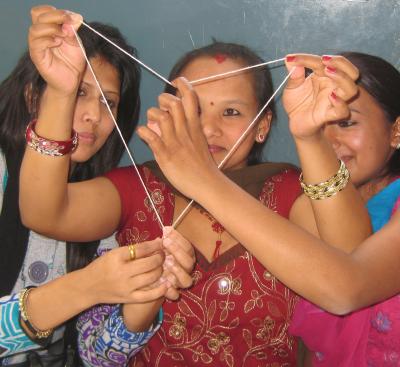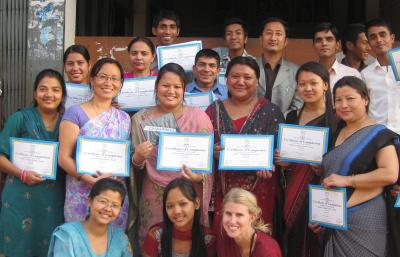Realizing that getting children into schools isn't enough to solve illiteracy, Rotary shifts to mentoring and coaching teachers
On Carolyn Johnson’s second visit to the central highlands of Guatemala, she met a first-grade teacher who made a shocking confession. Before taking part in the Guatemala Literacy Project, the teacher was convinced that her students could not learn to read.
“She said ‘We were willing to go through the program because it was a day out of class and you gave us books and you provided us with a nice lunch, but we knew that you were crazy,’ ” says Johnson, a Rotarian who helped design the curriculum for the project and now serves as a technical adviser for the Guatemala Literacy Project.

Students in Nepal develop critical-thinking skills by taking part in fun and creative activities led by their teachers.
Photo courtesy Nepal Teacher Training Innovations
That teacher and more than a hundred of her colleagues each received several in-classroom coaching sessions over eight months. They learned how to replace rote memorization drills and repetition of words on a blackboard with exercises that engage their students in critical thinking.
“She went on to tell me excitedly how 45 of her 50 students were moving on to second grade because they had learned to read,” Johnson says. “The program has made believers out of 90 percent of the teachers we have worked with. They are excited about being teachers again, and they go into their classrooms believing they can make a difference.”
After decades of investing in literacy projects, experts have realized that simply getting children into the classroom — either by removing attendance barriers or providing supplies — is not enough. Before students can succeed, the quality of the teaching in that classroom needs to improve.
Learning outcomes over enrollment
Rotary projects like the Guatemala Literacy Project and Nepal Teacher Training Innovations (NTTI) in Nepal are leading the effort to advance childhood reading by empowering teachers to teach better.
Rotary, the United Nations, USAID, and other organizations are shifting their focus to helping teachers plan lessons that ensure students will actually learn. The entire effort is part of a larger goal to reduce extreme poverty, because knowing how to read and write increases a person’s earning potential and ability to build a better life.
Quentin Wodon, a lead economist at the World Bank, has studied education projects both from a professional standpoint and as a member of the Rotary Club of Capitol Hill (Washington, DC), U.S.A. Wodon agrees that teachers are critical to any attempt to improve learning.
“The best way to enable children to learn is to think broadly about teacher policies,” says Wodon. Training is one of eight key goals set by the World Bank, along with setting clear expectations for teachers, attracting the best candidates, matching teacher skills with student needs, having strong principals to lead teachers, monitoring, providing ongoing support, and motivating teachers to perform.
-
122.00 million
children in the world are illiterate
-
75.00%
of people on public assistance in the U.S. can't read
Wodon’s club is working with the Rotary Club of Kathmandu, Nepal, to support NTTI and the nongovernmental organization PHASE in transforming classrooms where students are silent, passive learners into centers of active learning.
“Improving teaching methods is not an easy task, but programs like this are making inroads,” says Wodon.
For example, before taking part in the NTTI program, one teacher relied heavily on memorization, having her students copy words off the blackboard. After training, the teacher made her lesson on animate and inanimate objects more interactive, says Ashley Hager, NTTI’s director. The teacher asked children to point to objects and describe how they were different. She then listed the differences on the board and paired students up to discuss them. As a final exercise, the class went outside to find examples in nature.
One student approached the teacher with a live ant in her hand and inquired, “This is an animate object, yes?” The teacher agreed. The child then squashed the ant and asked, “Is it still an animate object now?” Caught by surprise, the teacher asked the rest of the students what they thought, and a lively conversation followed.
Other teachers agree that the training taught them the value of interactive teaching.
“It’s transformed my way of teaching and given me brilliant ideas to employ the best teaching practices I have learned,” says Goma Khada, who teaches fourth grade at Shrijana Higher Secondary School in Thumpakhar.

Teachers receive a certificate of completion after finishing the Nepal Teacher Training Innovations program. The program is transforming classrooms into centers of active learning, says Director Ashley Hager, front row right.
Photo courtesy Nepal Teacher Training Innovations
A model project
Another project that’s succeeding is Johnson’s Guatemala Literacy Project. The program began 20 years ago, setting up computer labs and supplying textbooks for middle school students in the western and central highlands. It has evolved to center on teacher mentoring.
Johnson, a member of the Rotary Club of Yarmouth, Maine, U.S.A., visited the region in 2006, seeking a literacy project for her district. She ended up leaving her job as a primary school principal after seeing the potential to address a deeper problem — the students’ poor reading skills.
“The primary school teacher in me realized you don’t start reading in the seventh grade. You have to start in the first grade,” Johnson says.

Teacher training is a key component of Nepal Teacher Training Innovations, which is improving the classroom experience for both students and teachers.
Over the next year, she returned to Guatemala several times, meeting with nonprofits, teachers, community members, and school administrators. She developed a curriculum based on the Concentrated Language Encounter method used widely in other parts of the world. A partnership was formed with the nonprofit Cooperative for Education (CoEd), which has a strong presence in Guatemala.
Five trainers hired by CoEd, with the help of local Rotary members, lead three two-day training sessions, usually in January, April, and July, for about 150 primary school teachers. Between those sessions, each teacher receives in-class coaching.
The Guatemala Literacy Project still supplies textbooks and equips two computer centers where students get hands-on experience using standard business software like Windows, Word, and Excel for an hour a week. Fees collected by school administrators and managed by CoEd are used to replace books and equipment when they wear out.
Each year, a new global grant from The Rotary Foundation extends the effort to another 40 or so primary schools and a dozen middle schools selected after meetings with community leaders, parents, teachers, and administrators. More than 480 clubs in Guatemala, the United States, Canada, Cayman Islands, England, and Japan have provided financial support. Every year, about 50 Rotary volunteers take part by delivering materials and visiting classrooms.
After completing the training, most of the teachers continue to use what they’ve learned to enhance education in their communities.
“Does it always happen? No. But more often than not teachers continue to use the approach to learning, if not the specific model,” Johnson says.
The need to take action
USAID, a United States government agency that helps other countries, has long promoted reading in the early grades. Its programs emphasize adequate professional development and ongoing classroom support for teachers.
“All our early-grade reading projects include explicit teacher training, with an initial training followed by refresher trainings during the year,” says Evelyn Rodriguez-Perez, director of USAID’s Office of Education.
In Kenya, for instance, USAID partnered with the government on a national initiative that includes teaching guides, teacher coaching, and short-term professional development programs. The initiative reaches 1.1 million children a year.
The consequences of doing nothing are great. The International Commission on Financing Global Education Opportunity was formed to bring together world leaders, policy makers, and researchers to lobby for increased investment in education. The commission projects that if nothing changes, 264 million children from low-income countries will be failing to learn basic primary level skills by 2030. Only three in 10 will achieve minimum reading levels.

Experts agree: the more opportunities students have to be involved in the learning process, the better they do in school.
“Education, learning, and skill development will be increasingly important in the future,” says Justin Van Fleet, commission director and Chief of Staff to the UN Special Envoy for Global Education. “By 2050, the population of Africa will double, and billions of people will move to cities from rural areas as technology and automation replace up to half of today’s jobs.”
To counter these trends, the commission released a report to the UN in September that called for increasing global investment in education, from $1.3 trillion to $3 trillion by 2030.
Meanwhile, agencies working to improve learning outcomes are getting good results from peer coaching and mentoring. Perez says most of USAID’s early grade reading programs implement a “cascade model” of teacher training, where more skilled teachers receive training, and they in turn train other teachers.
This is a model that NTTI also employs. Teacher Khika Bahaur Bhandari was selected to serve as a mentor for NTTI after rising to the top of his district in Thumpakhar. Bhandari is convinced of the benefits of peer interaction.
“The best thing about the program is that teachers know they will be observed, so they feel pressure to do a good job,” Bhandari says. “Once students know their teacher is capable of teaching them in an engaging way, they get upset when the teacher tries to return to traditional lecture methods. So even teachers who are not committed continue to make lesson plans and use the methodology.”
Johnson says getting into classrooms once a month can be a challenge and increases costs, “but it is the piece that really makes it work.”
“A teacher can go to training and take it back to their classroom. But maybe it doesn’t work because you left a piece out, or maybe the teacher tries it and decides it doesn’t work so they aren’t going to do it again,” she adds. “You need somebody there to coach and model and give you feedback. To say ‘You’re doing great, but let’s look at this little corner and shape it differently.’ ”



